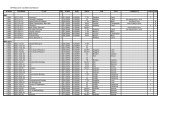Kenwood TH-D7A
Kenwood TH-D7A
Kenwood TH-D7A
You also want an ePaper? Increase the reach of your titles
YUMPU automatically turns print PDFs into web optimized ePapers that Google loves.
EQUIPMENT CONNECTIONS<br />
1<br />
2<br />
3<br />
4<br />
5<br />
6<br />
7<br />
8<br />
9<br />
10<br />
11<br />
12<br />
13<br />
14<br />
15<br />
16<br />
17<br />
18<br />
19<br />
20<br />
21<br />
22<br />
23<br />
CONNECTING EQUIPMENT FOR REMOTE CONTROL<br />
Make connections as shown when remotely controlling<br />
equipment.<br />
Note 1:<br />
Note 2:<br />
SP jack<br />
MIC jack<br />
Note 1<br />
Lock SW<br />
Ø2.5<br />
plug<br />
SW-1 3.9K<br />
Ø3.5<br />
plug<br />
SW-2 10K<br />
SW-3 27K<br />
PTT switch<br />
Note 2 10 µF<br />
External<br />
speaker<br />
External<br />
microphone<br />
Voltage is developed across the 100 Ω resistor in the 3.5 V line<br />
in the transceiver. When 2 mA flows, approximately 3.3 V is<br />
developed.<br />
A 10 µF capacitor is not required in the following cases:<br />
• When the other equipment has DC blocking capacitors.<br />
• When a 2-terminal electret condenser microphone is used.<br />
CONNECTING O<strong>TH</strong>ER EXTERNAL EQUIPMENT<br />
When connecting an external speaker, an external<br />
microphone, or other equipment such as a TNC for<br />
packet radio to the SP jack or MIC jack, refer to the<br />
diagram below.<br />
Speaker<br />
SP<br />
Ground<br />
3.5 V<br />
MIC<br />
PTT<br />
Note 1:<br />
Note 2:<br />
100 Ω<br />
MIC<br />
PTT<br />
3.5 V<br />
Note 1<br />
Ø2.5<br />
plug<br />
Ø3.5<br />
plug<br />
PTT switch<br />
Note 2 10µF<br />
External<br />
speaker,<br />
TNC RX, etc.<br />
External<br />
microphone,<br />
TNC TX, etc.<br />
Voltage is developed across the 100 Ω resistor in the 3.5 V line<br />
in the transceiver. When 2 mA flows, approximately 3.3 V is<br />
developed.<br />
A 10 µF capacitor is not required in the following cases:<br />
• When the other equipment has DC blocking capacitors.<br />
• When a 2-terminal electret condenser microphone is used.<br />
96

















